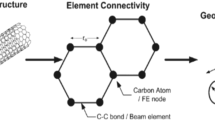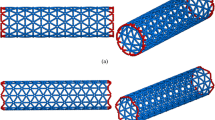Abstract
The present work investigates Young’s modulus of hexagonal nanosheets and nanotubes based on dimensional analysis and molecular mechanics. Using second derivatives of the strain energy density revealed from molecular dynamics simulations at 0 K (i.e., molecular mechanics) with harmonic potentials for various combinations of force constants, Young’s modulus have been computed for single-walled armchair and zigzag nanotubes of different radii. This parametric study with the aid of dimensional analysis allows explicitly establishing Young’s modulus of (n, n) armchair and (n, 0) zigzag nanotubes as functions of the force constants, bond length and chiral index n. Proposed formulae are applied to estimate Young’s modulus of graphene, boron nitride, silicon carbide sheets and their nanotubes. The accuracy of the proposed formulae are verified and discussed with available data in the literature for these three sheets and their nanotubes.





Similar content being viewed by others
References
Iijima S (1991) Helical microtubules of graphitic carbon. Nature 354:56
Fan Y (2011) Formation of crystalline AlN nanotubes by a roll-up approach. Mater Lett 65:1900–1902
Sorokin PB, Fedorov AS, Chernozatonskiĭ LA (2006) Structure and properties of BeO nanotubes. Phys Solid State 48:398–401
Chopra NG, Luyken RJ, Cherry K, Crespi VH, Cohen ML, Louie SG, Zettl A (1995) Boron nitride nanotubes. Science 269:966–967
Zhi C, Bando Y, Tang C, Golberg D (2010) Boron nitride nanotubes. Mater Sci Eng R 70:92–111
Sun XH, Li CP, Wong WK, Wong NB, Lee CS, Lee ST, Teo BK (2002) Formation of silicon carbide nanotubes and nanowires via reaction of silicon (from disproportionation of silicon monoxide) with carbon nanotubes. J Am Chem Soc 124:14464
Pacilé D, Meyer JC, Girit ÇÖ, Zettl A (2008) The two-dimensional phase of boron nitride: few-atomic-layer sheets and suspended membranes. Appl Phys Lett 92:133107
Shi Y, Hamsen C, Jia X, Kim KK, Reina A, Hofmann M, Hsu AL, Zhang K, Li H, Juang ZY, Dresselhaus MS, Li LJ, Kong J (2010) Synthesis of few-layer hexagonal boron nitride thin film by chemical vapor deposition. Nano Lett 10:4134
Song L, Ci L, Lu H, Sorokin PB, Jin C, Ni J, Kvashnin AG, Kvashnin DG, Lou J, Yakobson BI, Ajayan PM (2010) Large scale growth and characterization of atomic hexagonal boron nitride layers. Nano Lett 10:3209
Lin SS (2012) Light-emitting two-dimensional ultrathin silicon carbide. J Phys Chem C 116:3951
Chang T, Gao H (2003) Size-dependent elastic properties of a single-walled carbon nanotube via a molecular mechanics model. J Mech Phys Solids 51:1059–1074
Natsuki T, Tantrakarn K, Endo M (2004) Prediction of elastic properties for single-walled carbon nanotubes. Carbon 42:39–45
Jiang L, Guo W (2011) A molecular mechanics study on size-dependent elastic properties of single-walled boron nitride nanotubes. J Mech Phys Solids 59:1204–1213
Cheng Y, Shi G (2012) The prediction of mechanical properties of graphene by molecular mechanics and structural mechanics method. Adv Mater Res 583:403–407
Berinskii IE, Borodich FM (2013) Elastic in-plane properties of 2D linearized models of graphene. Mech Mater 62:60–68
Odegard GM, Gates TS, Nicholson LM, Wise KE (2002) Equivalent-continuum modeling of nano-structured materials. Compos Sci Technol 62:1869–1880
Li C, Chou TW (2003) A structural mechanics approach for the analysis of carbon nanotubes. Int J Solids Struct 40:2487–2499
Tserpes KI, Papanikos P (2005) Finite element modeling of single-walled carbon nanotubes. Compos B 36:468–477
Scarpa F, Adhikari S, Phani AS (2009) Effective elastic mechanical properties of single layer graphene sheets. Nanotechnology 20:065709
Shokrieh MM, Rafiee R (2010) Prediction of Young’s modulus of graphene sheets and carbon nanotubes using nanoscale continuum mechanics approach. Mater Des 31:790–795
Lei X, Natsuki T, Shi J, Ni QQ (2011) Analysis of carbon nanotubes on the mechanical properties at atomic scale. J Nanomater 2011:1
Boldrin L, Scarpa F, Chowdhury R, Adhikari S (2011) Effective mechanical properties of hexagonal boron nitride nanosheets. Nanotechnology 22:505702
Scarpa F, Adhikari S (2008) A mechanical equivalence for Poisson’s ratio and thickness of C–C bonds in single wall carbon nanotubes. J Phys D Appl Phys 41(8):085306
Liu X, Metcalf TH, Robinson JT, Houston BH, Scarpa F (2012) Shear modulus of monolayer graphene prepared by chemical vapor deposition. Nano Lett 12(2):1013–1017
Kudin KN, Scuseria GE, Yakobson BI (2001) C2F, BN, and C nanoshell elasticity from ab initio computations. Phys Rev B 64:235406
Tu ZC, Ou-Yang Z (2002) Single-walled and multiwalled carbon nanotubes viewed as elastic tubes with the effective Young’s moduli dependent on layer number. Phys Rev B 65:233407
Pantano A, Parks DM, Boyce MC (2004) Mechanics of deformation of single- and multi-wall carbon nanotubes. J Mech Phys Solids 52:789
Huang Y, Wu J, Hwang KC (2006) Thickness of graphene and single-wall carbon nanotubes. Phys Rev B 74:245413
Ru CQ (2009) Chirality-dependent mechanical behavior of carbon nanotubes based on an anisotropic elastic shell model. Math Mech Solids 14:88–101
Chang T (2010) A molecular based anisotropic shell model for single-walled carbon nanotubes. J Mech Phys Solids 58:1422–1433
Arroyo M, Belytschko T (2002) An atomistic-based finite deformation membrane for single layer crystalline films. J Mech Phys Solids 50:1941–1977
Zhang P, Huang Y, Geubelle PH (2002) The elastic modulus of single-wall carbon nanotubes: a continuum analysis incorporating interatomic potentials. Int J Solids Struct 39:3893–3906
Jiang H, Zhang P, Liu B, Huang Y, Geubelle PH, Gao H, Hwang KC (2003) The effect of nanotube radius on the constitutive model for carbon nanotubes. Comput Mater Sci 28:429–442
Zhang HW, Wang JB, Guo X (2005) Predicting the elastic properties of single-walled carbon nanotubes. J Mech Phys Solids 53:1929–1950
Nasdala L, Kempe A, Rolfes R (2012) Are finite elements appropriate for use in molecular dynamic simulations. Compos Sci Technol 72:989–1000
Zhao J, Wang L, Jiang JW, Wang Z, Guo W, Rabczuk T (2013) A comparative study of two molecular mechanics models based on harmonic potentials. J Appl Phys 113:063509
Burkert U, Allinger NL (1982) Molecular mechanics. ACS Monograph 177. American Chemical Society, Washington, DC
Leach AR (2001) Molecular modelling principles and applications, chapter 4, 2nd edn. Prentice Hall, Englewood Cliffs
Rappe AK, Casewit CJ (1997) Molecular mechanics across chemistry. University Science Books
Barenblatt GI (1996) Scaling, self-similarity, and intermediate asymptotics. Cambridge University Press, Cambridge
Dresselhaus MS, Dresselhaus G, Saito R (1995) Physics of carbon nanotubes. Carbon 33:883–891
Plimpton SJ (1995) Fast parallel algorithms for short-range molecular dynamics. J Comp Phys 117:1
Mirnezhad M, Modarresi M, Ansari R, Roknabadi MR (2012) Effect of temperature on Young’s modulus of graphene. J Therm Stress 35:913–920
Mirnezhad M, Ansari R, Shahabodini A (2013) Temperature effect on Young’s modulus of boron nitride sheets. J Therm Stress 36:152–159
Schneider T, Stoll E (1978) Molecular-dynamics study of a three-dimensional one-component model for distortive phase transitions. Phys Rev B 17:1302–1322
Le MQ, Batra RC (2013) Single-edge crack growth in graphene sheets under tension. Comput Mater Sci 69:381–388
Le MQ, Batra RC (2014) Crack propagation in pre-strained single layer graphene sheets. Comput Mater Sci 84:238–243
Rappe AK, Casewit CJ, Colwell KS, Goddard WA III, Skid WM (1992) UFF, a full periodic table force field for molecular mechanics and molecular dynamics simulations. J Am Chem Soc 114(25):10024
Claeyssens F, Freeman CL, Allan NL, Sun Y, Ashfold MNR, Harding JH (2005) Growth of ZnO thin films—experiment and theory. J Mater Chem 15:139–148
Tu ZC, Hu X (2006) Elasticity and piezoelectricity of zinc oxide crystals, single layers, and possible single-walled nanotubes. Phys Rev B 74:035434
Sahin H, Cahangirov S, Topsakal M, Bekaroglu E, Akturk E, Senger RT, Ciraci S (2009) Monolayer honeycomb structures of group-IV elements and III–V binary compounds: first-principles calculations. Phys Rev B 80:155453
Topsakal M, Aktürk E, Ciraci S (2009) First-principles study of two- and one-dimensional honeycomb structures of boron nitride. Phys Rev B 79:115442
Zhang CW (2012) First-principles study on electronic structures and magnetic properties of AlN nanosheets and nanoribbons. J Appl Phys 111:043702
Hansson A, Mota FB, Rivelino R (2012) Metallic behavior in low-dimensional honeycomb SiB crystals: a first-principles prediction of atomic structure and electronic properties. Phys Rev B 86:195416
Kınacı A, Haskins JB, Sevik C, Cagın T (2012) Thermal conductivity of BN–C nanostructures. Phys Rev B 86:115410
Erhart P, Albe K (2005) Analytical potential for atomistic simulations of silicon, carbon, and silicon carbide. Phys Rev B 71:035211
Blasé X, Rubio A, Louie SG, Cohen ML (1994) Stability and band gap constancy of boron nitride nanotubes. Europhys Lett 28:335
Baumeier B, Krüger P, Pollmann J (2007) Structural, elastic, and electronic properties of SiC, BN, and BeO nanotubes. Phys Rev B 76:085407
Alam KM, Ray AK (2008) Hybrid density functional study of armchair SiC nanotubes. Phys Rev B 77:035436
Zhang ZH, Guo WL, Dai YT (2009) Stability and electronic properties of small boron nitride nanotubes. J Appl Phys 105(8):084312
Bogar F, Mintmire JW, Bartha F, Mező T, Van Alsenoy C (2005) Density-functional study of the mechanical and electronic properties of narrow carbon nanotubes under axial stress. Phys Rev B 72:085452
Ogata S, Shibutani Y (2003) Ideal tensile strength and band gap of single-walled carbon nanotubes. Phys Rev B 68:165409
Hernández E, Goze C, Bernier P, Rubio A (1998) Elastic properties of C and BxCyNz composite nanotubes. Phys Rev Lett 80:4502
Ganji MD, Fereidoon A, Jahanshahi M, Ahangari MG (2012) Elastic properties of SWCNTs with curved morphology: density functional tight binding based treatment. Solid State Commun 152:1526–1530
Fereidoon A, Ahangari MG, Ganji MD, Jahanshahi M (2012) Density functional theory investigation of the mechanical properties of single-walled carbon nanotubes. Comput Mater Sci 53:377–381
Liu F, Ming P, Li J (2007) Ab initio calculation of ideal strength and phonon instability of graphene under tension. Phys Rev B 76:064120
Wei X, Fragneaud B, Marianetti CA, Kysar JW (2009) Nonlinear elastic behavior of graphene: ab initio calculations to continuum description. Phys Rev B 80:205407
Xu M, Paci JT, Oswald J, Belytschko T (2012) A constitutive equation for graphene based on density functional theory. Int J Solids Struct 49:2582–2589
Andrew RC, Mapasha RE, Ukpong AM, Chetty N (2012) Mechanical properties of graphene and boronitrene. Phys Rev B 85:125428
Lee C, Wei X, Kysar JW, Hone J (2008) Measurement of the elastic properties and intrinsic strength of monolayer graphene. Science 321:385–388
Peng Q, Ji W, De S (2012) Mechanical properties of the hexagonal boron nitride monolayer: ab initio study. Comput Mater Sci 56:11
Le MQ (2014) Atomistic study on the tensile properties of hexagonal AlN, BN, GaN, InN and SiC sheets. J Comput Theor Nanosci 11:1458
Bosak A, Serrano J, Krisch M, Watanabe K, Taniguchi T, Kanda H (2006) Elasticity of hexagonal boron nitride: inelastic x-ray scattering measurements. Phys Rev B 73:041402R
Acknowledgments
This work was supported by Vietnam National Foundation for Science and Technology Development (NAFOSTED) under the grant number: 107.02-2011.10.
Author information
Authors and Affiliations
Corresponding author
Appendices
Appendix 1
See Table 6
Appendix 2: Estimation of the force constant from Tersoff and Tersoff-like potentials
The energy E of a bond with the bond angle kept constant is developed in a Taylor series for small bond extension Δr = r − r 0:
E(r 0) = 0, since the system is in equilibrium in unstrained state at r = r 0.
\( \frac{{\partial E\left( {r_{0} } \right)}}{\partial r} = 0 \), since E(r) have a minimum at r = r 0.
Using the notation Δr = δl ij , and regarding Eq. (2) and (19) yield
Hence K can be evaluated when E(r) is known from Tersoff or Tersoff-like potentials.
Rights and permissions
About this article
Cite this article
Le, MQ. Young’s modulus prediction of hexagonal nanosheets and nanotubes based on dimensional analysis and atomistic simulations. Meccanica 49, 1709–1719 (2014). https://doi.org/10.1007/s11012-014-9976-z
Received:
Accepted:
Published:
Issue Date:
DOI: https://doi.org/10.1007/s11012-014-9976-z




